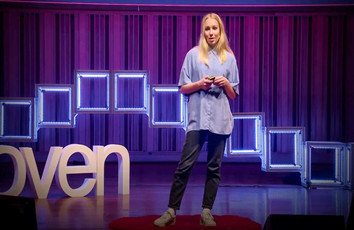TED | 放下偏见,拆掉你心里的墙
演讲简介
设计师亚历山德拉 · 欧尔(Alexandra Auer)指出,现代国家之间的墙比世界第二大战结束时还要多。而当你筑起一堵墙时,你不知不觉的还筑起了第二堵——一堵在我们脑海中划分出了“他们”和“我们”, 并且承诺给我们带来安全感的墙。欧尔在两所被围栏所分离的小学进行了一个社会设计项目,此项目不仅给我们带来了有趣的实验成果,还鼓励我们放下本有的偏见来看待大家所拥有的共同点。

演讲精彩片段(节选)欣赏
One global trend we are currently experiencing is the rise of gated communities. And in a way, gated communities can be seen the same exact way as countries, just on the small scale - neighborhoods surrounded by walls and fences to protect citizens from other citizens - and the only difference is, it's by choice.
我们现在所经历的一个全球趋势,是越来越多的封闭团体开始出现。这些封闭的团体和一个国家没有什么不同,只不过规模较小罢了——一个小区被墙跟围栏围绕着,只为了防止其他市民伤害里面的市民,唯一不同的是,这是人们的选择。
But the physical and mental effects on the people living inside and the people kept outside are the same, separating cities, neighborhoods and even playgrounds.
可这样做对住在里面和被隔离在外的人在身体和心理上造成的影响都是一样的——隔离了城市,街区,甚至游乐场。
In the spring of last year, I worked on a design project in Brussels at two elementary schools where this was the case. Both the schools share an entrance and the schoolyard. Both schools teach in Dutch.
去年春天,我在布鲁塞尔的两间小学进行了一个设计项目,得到的正是这样的结果。两间学校共享着一个入口跟操场,他们都用荷兰语教学。
But one school is mainly visited by Belgian children, and the other school, by immigrant children. The schools are separated by walls and fences, leaving the children no point of interaction other than this fence on the schoolyard that separates them.
但其中一间大多数学生都是比利时本地的孩子,而另一间都是移民的孩子。这两间学校被墙跟围栏隔离开来,以至于两所学校的学生没有地方交流,除了隔着这堵在操场中把他们分开的围栏。
When I started to work there, it made me sad to see children having to stand at a fence to talk to their friend on the other side. But what's even worse is that most of the children will never get the opportunity to even make a friend on the other side.
当我刚开始在那工作时,我为眼前的景象感到悲哀,小朋友要站在围栏边,才能与他们对面的朋友说话。但更可悲的是,大多数小朋友这一生都没有机会与对面的小孩交上朋友。
School should be the place where children, all children, come together and learn -- learn from the teacher, but more importantly, learn from each other. And the more diversity, the more there is to learn.
学校应该是一个让所有小孩都能聚到一起学习的地方——跟着他们的老师学习,但更重要的是,从对方身上学习。他们之间存在越多的差异,能学到的东西就越多。
In fact, school might be the only time in our lives where establishing a contact despite social differences is even possible. Separating children during this time of their development will make integration extremely difficult, if not impossible.
事实上,学校可能是我们一生中唯一能让我们和那些与自己拥有社会差异的人进行交流的地方了。在孩子处于成长时期就把他们隔离开,会把未来的统一变得更难,甚至完全不可能。
And yet, somehow, I seem to be the only one having a problem with this fence in Brussels. Most of the parents, teachers and children stopped seeing or at least questioning the structure. It's just how it is. Nobody has ever seen it differently. And people are in favor of it.
但不知道为什么,我似乎是整个布鲁塞尔唯一一个对这堵墙有意见的人。大多数的家长、老师和孩子,已经开始无视,或不再质问那堵墙的存在。现实就是这样,它对人们来说就只是一堵墙,人们甚至支持它的存在。
I once asked a boy if he would like to play with the other side, and he said, “No.” Then I asked if he would play with them if the fence wasn’t there, and he said, “Probably.” But then he quickly added that the fence should stay, because the other side is mean and they never give back his ball.
我有一次问一个小男孩,他想不想和对面的人玩,他说:“不。”然后我问他,如果没有这围栏,你会和他们玩吗?他说:“或许吧,”但他立马接着说,这围栏不应该消失,因为对面的人都很凶,扔过去的球他们从来都不还回来。
It’s funny, because I talked to children from both sides, and everyone told me that the other side is mean because they never give back the ball. The children on both sides dislike each other, and there are regularly arguments breaking out at this fence, which is also the main reason why people feel the need for it to be there:
我觉得有点好笑,因为两边的小孩我都问了,他们都说对面的人很凶,理由都是他们不把球还回来。两边的小孩互相讨厌,甚至还经常在围栏边争吵,这也是为什么很多人都认为,那围栏是必要的。
It protects the children from each other, or at least their toys, and it prevents chaos. At some point, the children started to crawl beneath the fence to get their ball back, and the reaction of the schools was to put these metal plates there. Now they climb over.
它能保护双方的孩子,至少能保护他们的玩具,和防止过分的争吵。不知道什么时候开始,小孩会从围栏下方爬过,只为了把球拿回来。学校采取的措施却是拿这些金属板把缝隙封住了。现在,小孩开始从上面翻越围栏了。


